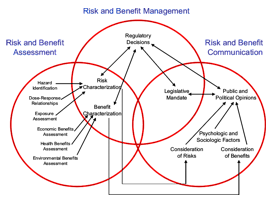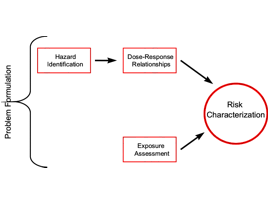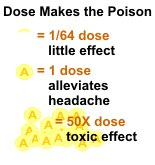|  |
|
I KNOW WHAT RISK IS, BUT HOW DO I ASSESS IT? The Risk Assessment Paradigm Dr. Robert K. D. Peterson
Agricultural & Biological Risk Assessment
Montana State University
bpeterson@montana.edu |

|
|
Risk assessment is really one component of a larger paradigm called Risk Analysis. Risk analysis encompasses risk assessment, risk management, and risk communication. We will discuss risk management and risk communication briefly, but this section is devoted primarily to risk assessment. |
Risk Analysis
Risk analysis arose only in the past 25 years as a formalized discipline. It was spawned by statutory frameworks for the regulation of health and environmental risks. Risk analysis is rapidly emerging as a discipline that is crucial for societal decision-making about modern technologies, such as biotechnology crops. The value of risk analysis derives from developing a rational framework whereby the knowledge-based description of risk (risk assessment) is integrated with social, cultural, economic, and political considerations to manage and communicate risk in policy decisions and implementation. Risk analysis is powerful because it deals transparently with the host of scientific, social, cultural, economic, and political issues that together shape a consensus approach in public policy decisions concerning technological risk.
|
 |
|
 Risk Assessment Risk Assessment
Risk assessment can be defined as a formalized basis for the objective evaluation of risk in a manner in which assumptions and uncertainties are clearly considered and presented. Risk assessment commonly involves multidisciplinary efforts among physical scientists, toxicologists, biologists, mathematical modelers, and information specialists. Major categories of risk assessment include chemical, cancer, microbial, complex engineered systems, natural phenomena (seismic, flood), radiation (nuclear power), ecological, occupational, and economic.
The risk assessment framework that is practiced most frequently today follows the “Red Book” paradigm, which was promulgated by the National Research Council in 1983. Risk assessment flows in a logical, stepwise fashion that includes the following steps: (1) problem formulation, (2) hazard identification, (3) dose-response relationships, (4) exposure assessment, and (5) risk characterization. Risk characterization is the culmination of the other steps. Hazard and dose are considered in juxtaposition with exposure to determine risk or to determine what additional data are needed to calculate risk or to refine risk estimates.
|
|
Problem Formulation
This is the first, and arguably most important, phase of risk assessment. Problem formulation is a systematic planning step for the actual assessment. It establishes the goals, breadth, and focus of the assessment. The following questions may be addressed during the problem formulation stage: What is the stressor or activity causing harm?; What are the potential ecological effects?; What are the potential human health effects?; What are the potential exposure scenarios? What are the potential routes of exposure?
Hazard Identification
We discussed what constitutes a hazard in the last section. Hazard identification merely is the act of determining what the hazard is and its ability to cause harm. For example, a specific protein, when ingested, may cause an allergic reaction in susceptible people.
Dose-Response Relationships
 To adequately understand this step, we will have to spend a little time discussing the fundamental concepts of toxicology. Probably the most fundamental concept in toxicology is that the dose makes the poison. Paracelsus (1493-1541) is credited with this dictum when he wrote, “All substances are poisons, there is none which is not a poison. The right dose differentiates a poison and a remedy.” In other words, the dose of the substance determines the effect on the organism. The dose is the amount of the substance administered to the organism, or the amount the organism is exposed to. Let’s use aspirin as an example. If you have a headache and take a miniscule amount of aspirin (say 1/64 of a tablet or 3 mg), the dose may not have any effect on you. If you take 1 tablet (the recommended dose or 200 mg), then there is an effect and your headache is alleviated. If you take 50 tablets, then you will experience symptoms of toxicity from the aspirin. The dose makes the poison. Every substance behaves like this. Remember from the previous section, excessive water consumption can lead to a toxic effect (hyponatremia). Of course, some substances are much more toxic than others, so they require much lower doses to exert a toxic effect. To adequately understand this step, we will have to spend a little time discussing the fundamental concepts of toxicology. Probably the most fundamental concept in toxicology is that the dose makes the poison. Paracelsus (1493-1541) is credited with this dictum when he wrote, “All substances are poisons, there is none which is not a poison. The right dose differentiates a poison and a remedy.” In other words, the dose of the substance determines the effect on the organism. The dose is the amount of the substance administered to the organism, or the amount the organism is exposed to. Let’s use aspirin as an example. If you have a headache and take a miniscule amount of aspirin (say 1/64 of a tablet or 3 mg), the dose may not have any effect on you. If you take 1 tablet (the recommended dose or 200 mg), then there is an effect and your headache is alleviated. If you take 50 tablets, then you will experience symptoms of toxicity from the aspirin. The dose makes the poison. Every substance behaves like this. Remember from the previous section, excessive water consumption can lead to a toxic effect (hyponatremia). Of course, some substances are much more toxic than others, so they require much lower doses to exert a toxic effect.
Here are a couple of other examples from Toxicology: An Environmental Education Unit for Secondary Schools and Community (1995). Alberta Environmental Protection and the Canadian Network of Toxicology Centres:
- “Bread contains alcohol produced by the fermentation of sugars by yeast. The amount of alcohol in a slice of bread, or a loaf of bread, for that matter, is too small to cause a response (drunkenness) in humans. However, a bottle of liquor, also made by the fermentation of sugars by yeast contains a large enough does of alcohol to make most people drunk or even, in some cases, to kill them.”
- “Vitamins are a special case of toxicity where insufficient consumption will make you sick (for example, scurvy from lack of vitamin C). Consumption of moderate amounts of vitamins is necessary for health but excess consumption of some vitamins can be very dangerous.”
Once a person or other organism is dosed with a substance, the substance may be absorbed, distributed, metabolized, and excreted from the body. In addition to dose, the toxicity of a substance depends on where and how the substance is transported through the body.
Absorption
Absorption is the transport of a substance from the exposed surface to the blood. If you ingest the substance, it goes through the gastrointestinal tract before entering the blood. If you inhale the chemical, it goes through the lung and then to the blood. If the chemical gets on your skin, it is absorbed through your skin and then to the blood.
Distribution
Once absorbed, substances move from the blood to the various organs in the body. For example, a chemical may move from the blood to the liver and kidneys, but not to other organs. Or, the substance may move from the blood to a fetus.
Metabolism
Some chemicals are transformed by the body to aid in their excretion. This is called metabolism. The liver and other organs may detoxify the chemicals into less toxic (or even more toxic) substances
Excretion
Finally, the chemicals or their metabolized forms may be excreted by the body through urine, feces, or exhaled air.
|

|
|











